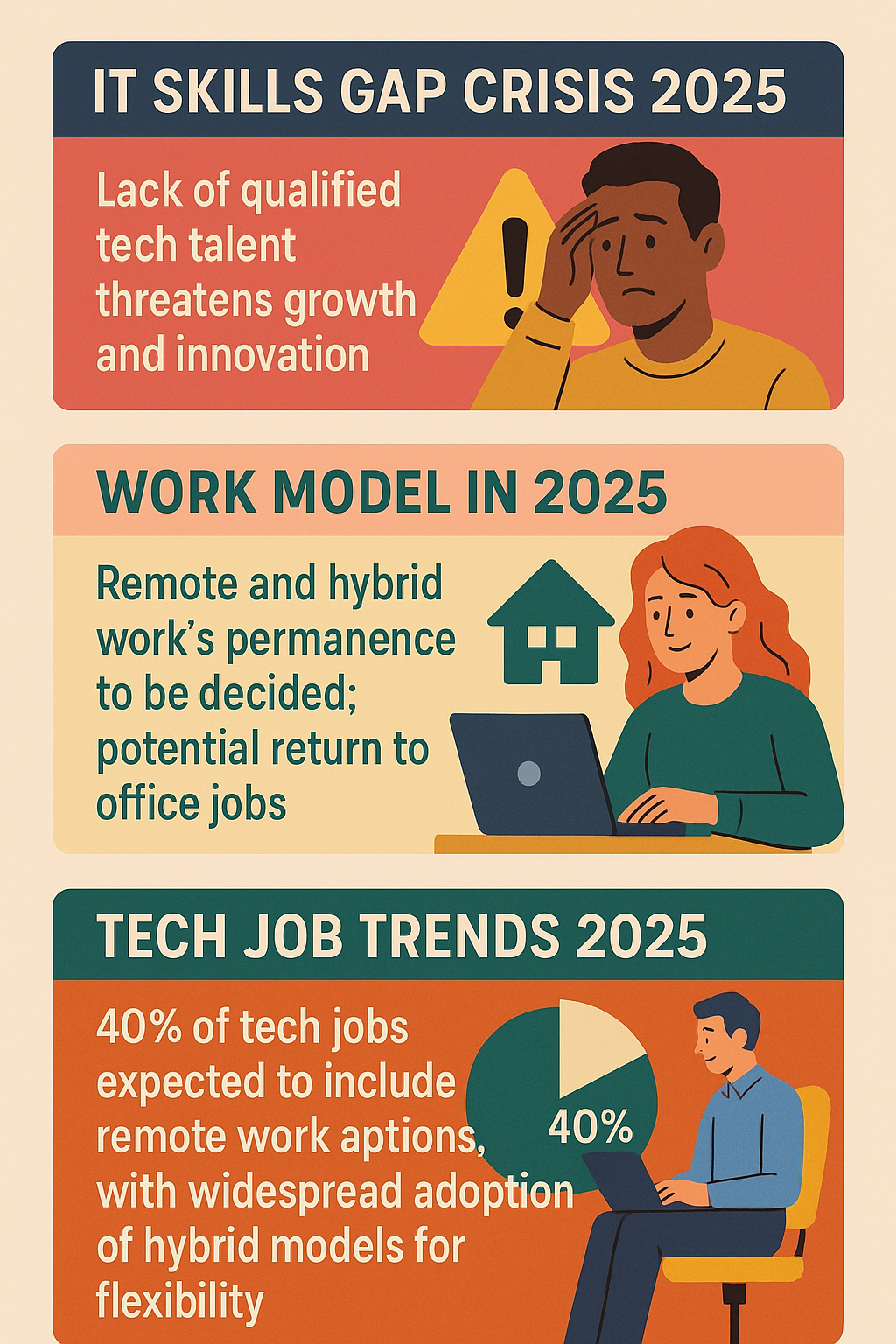Global Scans · Future of Work & Skills Gaps · Signal Scanner
Emerging Hybrid Collaboration Ecosystems: The Next Frontier in Workforce Evolution
The acceleration of remote and hybrid work arrangements is widely noted across industries, yet a subtler, emerging phenomenon tied to “hybrid collaboration ecosystems” is gaining traction. Beyond flexible work schedules, these ecosystems integrate advanced digital platforms, public-private workforce development initiatives, and shifting geographic and regulatory dynamics to reshape how workforces connect, upskill, and deliver value. This weak signal points to a future where workforce development, technology, and organizational culture coalesce in unprecedented ways that may disrupt traditional job markets, talent pipelines, and corporate governance.
What’s Changing?
The hybrid work trend has moved beyond an initial reaction to the pandemic into a durable model potentially defining work culture for the foreseeable future. By 2025, about 40% of technology-related roles are expected to offer remote or hybrid options, combining office presence with digital workspaces (TechNeeds 2025 Tech Job Trends).
This shift enables a broader geographical talent pool and alters the dynamics of recruitment and retention. However, the transition’s complexity extends beyond simply working from home. Companies increasingly rely on digital platforms for networking and collaboration, such as LinkedIn, industry-specific forums, and virtual meetups, to enhance visibility and facilitate knowledge-sharing in dispersed teams (CareerAheadOnline Virtual Networking).
Public-private partnerships are responding by funding workforce development programs tailored to close skill gaps that traditional educational institutions and singular corporate efforts have struggled to address (>50% of requisite future skills may be newly emerging or hybrid in nature). These programs focus not only on technical skills but also on digital fluency, agile teamwork, and cross-sector knowledge transfer (HR Dive Workforce Development).
Europe’s regional economic growth projections, fueled by cloud migration and EU digital funding, highlight the role of supportive regulatory environments and infrastructure investment in sustaining this ecosystem trend. These factors suggest that digital transformation and remote-work frameworks may reinforce each other in creating new centers of innovation and employment (ResearchNester EU Digital Growth).
Why Is This Important?
The emergence of hybrid collaboration ecosystems challenges the conventional division between “the office” and “remote work.” Instead, it invites a redefinition of workspaces as distributed, multifaceted networks. This has several immediate and long-term implications:
- Talent acquisition and retention may increasingly depend on a company’s ability to foster connectedness across virtual and physical environments and continuously develop hybrid skill sets.
- Organizational agility could improve with ecosystems that blend public-sector training initiatives, private-sector innovation, and flexible governance, allowing faster adaptation to industry disruptions.
- Regional economic shifts might accelerate as clusters emerge around digital infrastructure hubs rather than traditional business districts, further decentralizing economic opportunity.
- Employee experience will evolve to prioritize not only work-life balance via flexibility but also digital collaboration fluency and access to networked learning.
These factors could unsettle existing industry boundaries, compel investment in digital ecosystem platforms beyond standard remote work tools, and require new governance models for workforce development partnerships.
Implications
The hybrid collaboration ecosystem may drive enterprises to integrate multiple digital and social platforms to support both formal work functions and informal knowledge exchange, creating a “networked workplace.” This integration might demand increased investment in cybersecurity, data privacy, and governance transparency as more stakeholders participate across sectors and jurisdictions.
Public-private workforce programs could evolve from remediation-focused efforts addressing short-term skill shortages into continuous, on-demand learning ecosystems. These might leverage AI-driven personalized learning paths, virtual apprenticeships, and cross-sector rotations to prepare workers for hybrid roles that blend technical, social, and strategic skills.
Industries not traditionally associated with remote work, such as manufacturing or healthcare, could adopt elements of these hybrid models for back-office, planning, and training activities, disrupting established workflows and organizational hierarchies.
Regions investing proactively in digital infrastructure and ecosystem governance may become hubs attracting global talent, while others risk economic lag or brain drain. This geographic dimension reinforces the strategic value of aligning workforce strategies with broader urban and regulatory planning.
For governments and policy makers, fostering hybrid collaboration ecosystems could offer pathways to enhance inclusivity in labor markets, support lifelong learning, and balance economic decentralization with national competitiveness.
Questions
- How can organizations evaluate and adopt digital collaboration platforms that integrate seamlessly into hybrid ecosystems rather than stand-alone solutions?
- What frameworks can governments and private sectors apply to align workforce development investments with emerging hybrid collaboration demands?
- Which governance models can balance innovation, data security, and worker rights within increasingly networked and multi-stakeholder work ecosystems?
- How might regional economic strategies shift to leverage ecosystem-driven talent attraction and retention effectively?
- What new metrics should HR and strategic planners use to measure productivity and employee engagement in hybrid collaboration environments?
Addressing these questions will help businesses and policymakers anticipate and shape the trajectories of workforce ecosystems, turning a weak but growing signal into a strategic asset.
Keywords
hybrid collaboration ecosystems; remote work; workforce development; digital workplace; public-private partnerships; regional economic shifts; skill upskilling; organizational agility
Bibliography
- Workforce development programs - funded through public-private partnerships - appear to bridge the skills gap by helping companies to scale and expanding opportunities for less skilled workers. HR Dive. https://www.hrdive.com/news/workforce-development-programs-bridge-skills-gap/753696/
- 2025 could be a year of determining whether remote and hybrid work is here to stay or if in-office jobs make a return. Qualee. https://www.qualee.com/blog/setting-the-stage-for-2025-december-as-a-springboard-the-future
- By 2025, approximately 40% of tech job trends are expected to include remote work options, with many companies adopting hybrid models that offer flexibility. TechNeeds. https://www.techneeds.com/2025/08/22/10-key-tech-job-trends-shaping-recruitment-in-2025/
- As remote work becomes more prevalent, leveraging digital platforms for networking - such as LinkedIn, industry-specific forums, and virtual meetups - can enhance visibility and create new opportunities. CareerAheadOnline. https://careeraheadonline.com/strategies-for-thriving-in-2025s-job-market/
- Europe is anticipated to command a substantial revenue share by 2035, supported by cloud migration momentum, EU digitization funding, and evolving remote-work frameworks. ResearchNester. https://www.researchnester.com/reports/project-management-software-market/4176
